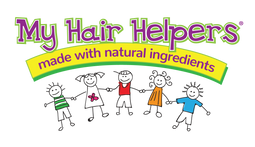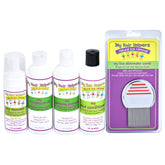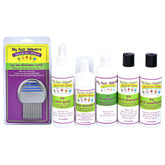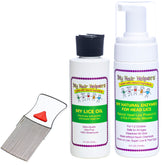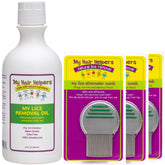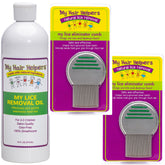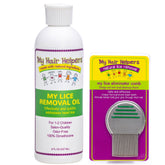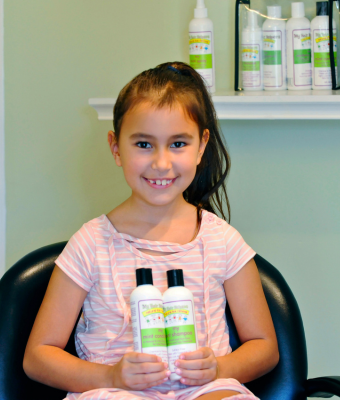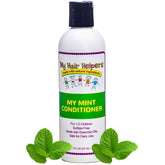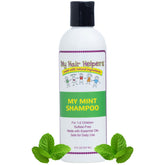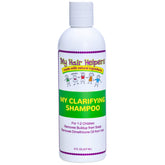WHAT DOES TREATMENT-RESISTANT HEAD LICE MEAN?

Parents and caregivers know the frustration of discovering head lice on a child’s scalp. Between the itching, the delicate comb-outs, and the special shampoos, an infestation can be time-consuming to manage. But what happens when these over-the-counter (OTC) products don’t seem to work? You might be dealing with treatment-resistant head lice, sometimes called “super lice.”
According to a 2023 study, 59% of human head lice are now resistant to insecticides. Fortunately, you don’t need to use insecticides to manage super lice—this can be done with natural products from My Hair Helpers. Let’s explore what treatment-resistant head lice are, why they occur, and how you can address them.
What Are Treatment-Resistant Head Lice?
Treatment-resistant head lice are lice that have developed resistance to the active ingredients commonly used in many OTC head lice treatments, such as permethrin or pyrethrins.
Over time, repeated or incorrect use of these medications can lead to genetic mutations in lice populations, making them less sensitive—or even completely unresponsive—to the chemicals designed to get rid of them. This phenomenon is similar to the way bacteria can become resistant to certain antibiotics.
Why Does Resistance Happen?
There are several reasons why resistance happens. First is the frequent use of the same ingredients. When the same solutions are used repeatedly in a community, the lice that are naturally resistant survive and reproduce, gradually creating a population that no longer responds well to standard products.
Second, improper application can contribute to resistance. Skipping recommended steps—like not leaving the shampoo on for the full recommended time or not following up with a second application—allows some lice to survive. These survivors can then carry and pass on the resistant trait.
Third, not all families are consistent in their management. If all household members or close contacts aren’t managed properly and simultaneously, lice can move freely between hosts, perpetuating a cycle of resistant infestations.
Signs You Might Be Dealing with Super Lice
- Persistent Live Lice After Treatment: Despite using an OTC product according to instructions, you still see active, moving lice a day or two later.
- Ongoing Itching: The affected individual continues to scratch intensely, indicating that the lice may not be gone.
- Multiple Failed Attempts: If you have tried the recommended approach more than once (including the follow-up) and are still seeing no improvement.
Potential Solutions and Next Steps
There are several options you have when you find that head lice aren’t being managed by OTC products. You can call your doctor, you can manually remove the lice through wet combing, or you can contact professional lice removal services. Each option has its pros and cons. However, we recommend the line of products from My Hair Helpers, which has proven effective against ALL lice—even treatment-resistant head lice.
Here’s how the process works:
- Mix a few drops of My Mint Conditioner into a spray bottle with water and use it to soften the hair. Use a detangling comb to remove tangles.
- Section hair and place a layer of My Natural Enzymes onto the scalp. Do this for each section, leaving on for five minutes. Do not rinse. Repeat with a second layer and leave on for another five minutes. Do not rinse.
- Use My Lice Oil or My Cocomint Oil and massage onto a dry scalp. This process traps and slows down bugs.
- Use the lice comb to comb each section of hair. With each combing movement, wipe the comb on a paper towel. Comb until the paper towel swipes clean.
- Apply more product and sleep in oil overnight. Wear a shower cap to protect your bedding.
- In the morning, wash the hair using My Clarifying Shampoo or My Mint Shampoo and then apply conditioner.
Can Treatment-Resistant Lice Be Prevented?
While there’s no foolproof way to stop lice entirely (they’re highly contagious), you can reduce the chances of dealing with resistant lice by following label instructions carefully for any lice product and using it only when necessary—not as a “just in case” measure. Periodic checks and immediate action at the first sign of lice can also help keep infestations under control before they spread or become resistant.
Final Thoughts
Treatment-resistant head lice are a growing challenge for parents, schools, and caregivers. However, by recognizing the signs of resistance early, you can find the right approach to resolve the infestation. Most importantly, don’t panic! With patience, proper management, and preventive steps, you can eradicate these pesky critters and help prevent future recurrences.
